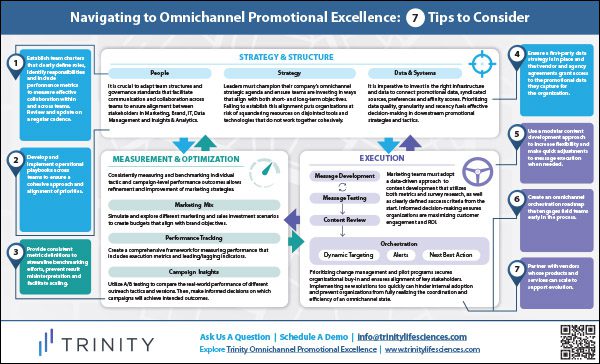Navigating to Omnichannel Promotional Excellence: Seven Tips to Consider

The organizational changes and coordination needed to successfully pull off omnichannel customer engagement can be overwhelming.
For a change of pace, we challenged the Trinity Analytics team to come up with simple, powerful tips that can vastly impact the success and pace of promotional omnichannel initiatives across three core focus areas.
Strategy & Structure
People
It is crucial to adapt team structures and governance standards that facilitate communication and collaboration across teams to ensure alignment between stakeholders in Marketing, Brand, IT, Data Management and Insights & Analytics.
Tip 1: Establish team charters that clearly define roles, identify responsibilities and include performance metrics to measure effective collaboration within and across teams. Review and update on a regular cadence.
Strategy
Leaders must champion their company’s omnichannel strategic agenda and ensure teams are investing in ways that align with both short- and long-term objectives. Failing to establish this alignment puts organizations at risk of squandering resources on disjointed tools and technologies that do not work together cohesively.
Tip 2: Develop and implement operational playbooks across teams to ensure a cohesive approach and alignment of priorities.
Data & Systems
It is imperative to invest in the right infrastructure and data to connect promotional data, syndicated sources, preferences and affinity scores. Prioritizing data quality, granularity and recency fuels effective decision-making in downstream promotional strategies and tactics.
Tip 3: Ensure a first-party data strategy is in place and that vendor and agency agreements grant access to the promotional data they capture for the organization.
Measurement & Optimization
Consistently measuring and benchmarking individual tactic and campaign-level performance outcomes allows refinement and improvement of marketing strategies.
Marketing Mix
Simulate and explore different marketing and sales investment scenarios to create budgets that align with brand objectives.
Performance Tracking
Create a comprehensive framework for measuring performance that includes execution metrics and leading/lagging indicators.
Campaign Insights
Utilize A/B testing to compare the real-world performance of different outreach tactics and versions. Then, make informed decisions on which campaigns will achieve intended outcomes.
Tip 4: Provide consistent metric definitions to streamline benchmarking efforts, prevent result misinterpretation and facilitate scaling.
Execution
Marketing teams must adopt a data-driven approach to content development that utilizes both metrics and survey research, as well as clearly defined success criteria from the start. Informed decision-making ensures organizations are maximizing customer engagement and ROI.
Tip 5: Use a modular content development approach to increase flexibility and make quick adjustments to message execution when needed.
Message Development

Message Testing
Content Review
Orchestration
Dynamic Targeting | Alerts | Next Best Action
Prioritizing change management and pilot programs secures organizational buy-in and ensures alignment of key stakeholders. Implementing new solutions too quickly can hinder internal adoption and prevent organizations from fully realizing the coordination and efficiency of an omnichannel state.
Tip 6: Create an omnichannel orchestration roadmap that engages field teams early in the process.
Tip 7: Partner with vendors whose products and services can scale to support evolution.
Download the PDF
Explore further thought leadership on Omnichannel
- On-demand Webinar: Driving Commercial Success with AI: Build, Calibrate and Operationalize
- On-demand Webinar: A Practical Omnichannel Vision: From Strategy to Execution and Optimization
- Virtual Lunch and Learn: Trinity MMx Studio
